Review: The BenQ 27-inch DesignVue UHD Thunderbolt 3 is an asset for designers, photograph...
AppleInsider goes hands on with BenQ's 27-inch DesignVue UHD Thunderbolt 3 Display, an adaptable, ultra-high definition monitor with plenty of features to please even the most fickle designer.
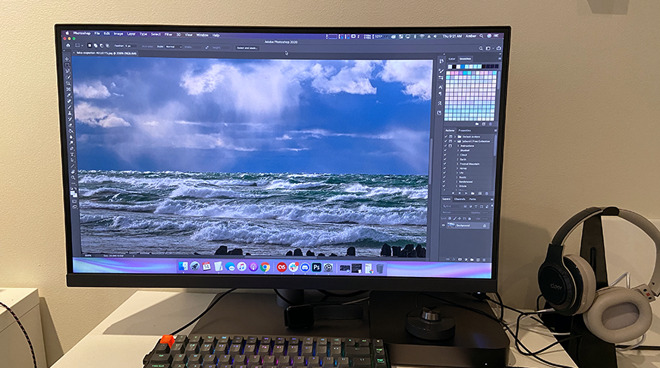
With the advent of high definition video and photography, digital artists have had to step up their display game in order to get the most out of their work. The DesignVue is a reasonably priced monitor geared toward designers, video editors, and photographers.
It's also got a fair amount of tilt, and if for some reason you need to pivot the monitor 90 degrees to vertical orientation mode, it can do that as well -- just like the BenQ 32-inch display we checked out in February.
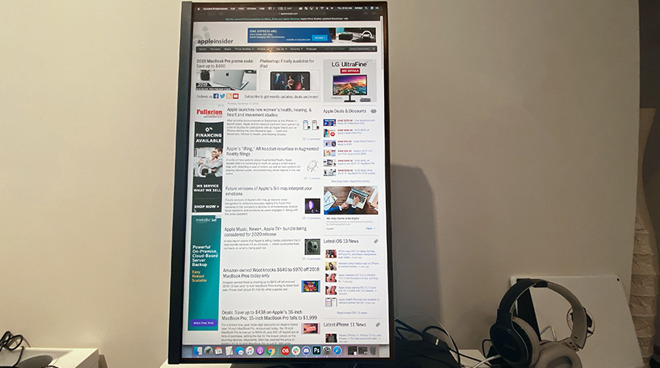
The DesignVue 27" rotated to portrait mode
The anti-glare coating on the monitor is also likely to be appreciated by those who work in brightly lit offices. I found that even on the brightest day, the screen was easy to view with no glare washing out the dark.
And if you're someone who has a lot of different devices to hook up to a monitor, you'll be pretty happy with this one. The DesignVue has the standard DisplayPort 1.4 and dual HDMI 2.0 ports, as well as two USB 3.1 ports. It also has two Thunderbolt 3 ports, which is what I used to connect to my Mac Mini. This also supports power delivery, allowing you to attach peripherals, charge laptops, and daisy-chain displays together.
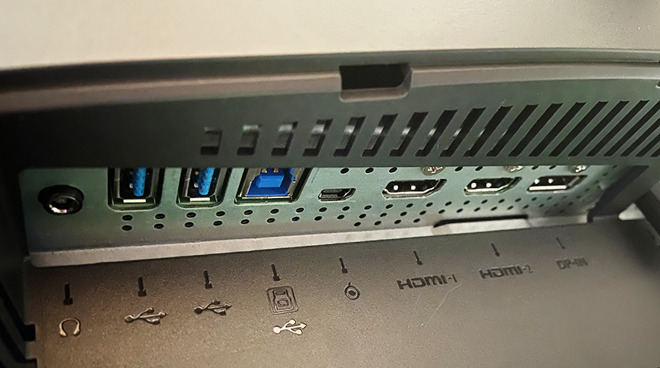
A selection of ports on the the 27-inch DesignVue Monitor
One port provides 65 watts of power and the other just 15 watts of power, so only one can power laptops and other monitors, but it's a nice option to have.
The On Screen Display (OSD) control of the DesignVue monitor is, thankfully, pretty easy to use. A small, easy-to-use joystick navigates the menu and the basic buttons enable you to quickly toggle between common setups.
Beyond the on-screen option, BenQ also provides a USB-based puck to interface with the DesignVue monitor. It's a similar idea to the more general-purpose Griffin PowerMate or Microsoft Surface Dial, and I loved using it. Three shortcut keys give you the ability to toggle between three favorite setups, and the joystick and menu buttons allow you to enter the OSD to change options or enter into picture-in-picture mode.
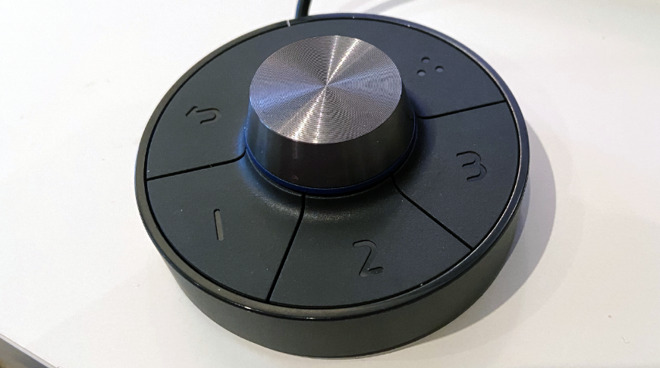
The BenQ hotkey puck
For designers, it's worth noting the monitor is capable of displaying about 1.07 billion colors. It covers 96% of the DCI-P3 gamut, 100% of the sRGB gamut, and 99% of Adobe's RGB gamut. It's got a pixel density of 163, which is decent, though it's nothing revolutionary, either.
The BenQ DesignVue comes-pre color calibrated, and I found that I didn't need to calibrate the monitor all that much to get it where I wanted it to be.
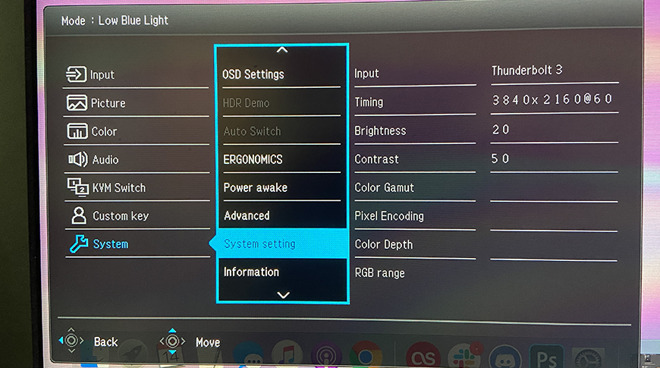
The BenQ OSD
However, it's not only that headphones or the Mac are convenient. It's also partly because as far as speakers go, the BenQ DesignVue's speakers aren't great quality. Sure, they play sound, but it sounds hollowed out and generally unpleasant. I don't think that's much of a demerit to the monitor, though.

With the advent of high definition video and photography, digital artists have had to step up their display game in order to get the most out of their work. The DesignVue is a reasonably priced monitor geared toward designers, video editors, and photographers.
Build Quality & Features
For a 27-inch monitor, the DesignVue is pretty darn impressive, and that's true before you even switch it on. For the monitor sits on a spring-loaded base, so if you're a person who likes to transition between sitting and standing throughout the day, the DesignVue effortlessly transitions with you.It's also got a fair amount of tilt, and if for some reason you need to pivot the monitor 90 degrees to vertical orientation mode, it can do that as well -- just like the BenQ 32-inch display we checked out in February.

The DesignVue 27" rotated to portrait mode
The anti-glare coating on the monitor is also likely to be appreciated by those who work in brightly lit offices. I found that even on the brightest day, the screen was easy to view with no glare washing out the dark.
And if you're someone who has a lot of different devices to hook up to a monitor, you'll be pretty happy with this one. The DesignVue has the standard DisplayPort 1.4 and dual HDMI 2.0 ports, as well as two USB 3.1 ports. It also has two Thunderbolt 3 ports, which is what I used to connect to my Mac Mini. This also supports power delivery, allowing you to attach peripherals, charge laptops, and daisy-chain displays together.

A selection of ports on the the 27-inch DesignVue Monitor
One port provides 65 watts of power and the other just 15 watts of power, so only one can power laptops and other monitors, but it's a nice option to have.
The On Screen Display (OSD) control of the DesignVue monitor is, thankfully, pretty easy to use. A small, easy-to-use joystick navigates the menu and the basic buttons enable you to quickly toggle between common setups.
Beyond the on-screen option, BenQ also provides a USB-based puck to interface with the DesignVue monitor. It's a similar idea to the more general-purpose Griffin PowerMate or Microsoft Surface Dial, and I loved using it. Three shortcut keys give you the ability to toggle between three favorite setups, and the joystick and menu buttons allow you to enter the OSD to change options or enter into picture-in-picture mode.

The BenQ hotkey puck
Specifications
The DesignVue is an IPS monitor with a maximum resolution is 3840x2160 and a brightness measurement of 350cd/. The native contrast hovers in just around 1000:1, which lends itself well to highly detailed images and produces incredibly crisp text.For designers, it's worth noting the monitor is capable of displaying about 1.07 billion colors. It covers 96% of the DCI-P3 gamut, 100% of the sRGB gamut, and 99% of Adobe's RGB gamut. It's got a pixel density of 163, which is decent, though it's nothing revolutionary, either.
Image Quality
As a person who works with images quite a bit, I thought the BenQ was more than sufficient for my day-to-day needs. There are a bunch of different modes you can quickly switch between to meet your needs, including an HDR mode, low blue light, Adobe RGB, and several more. The DesignVue also comes with HDR10 support, so if you're shooting high dynamic range video, you can edit it accurately with this monitor.The BenQ DesignVue comes-pre color calibrated, and I found that I didn't need to calibrate the monitor all that much to get it where I wanted it to be.

The BenQ OSD
Audio quality
The DesignVue comes with built-in speakers, though I never really thought to use them much. This is partly because I have a Mac mini, which I have for general audio, or I use headphones to avoid annoying other people in the room.However, it's not only that headphones or the Mac are convenient. It's also partly because as far as speakers go, the BenQ DesignVue's speakers aren't great quality. Sure, they play sound, but it sounds hollowed out and generally unpleasant. I don't think that's much of a demerit to the monitor, though.
Overall & where to buy
If you're a designer and want a monitor that has tons of features at a somewhat moderate price point, the DesignVue 27-inch 4K UHD Thunderbolt 3 Monitor might be the monitor for you. The PD2720U is available from Amazon for $999.99 and B&H Photo for $999.99.Rating: 4 out of 5 Stars
- Pros
- Plenty of different modes
- Features HDR10
- Cons
- Pixel density is decent, not great
- Audio quality is poor

Comments
the price is good enough for what it is. Not sure it qualifies to be equivalent to the real pro monitors out there though. They’re about 50% more, and up
I won't even think about a monitor smaller than 43" anymore...
PC monitors aren't more than 4k because Windows would look too small on a 27", so you just don't get non-Apple designed 5k 27" monitors, there were a couple of attempts but the Dell one needed 2 cables and the Iiyama suffered from many dead pixels. On Windows 4k is "ultra-high" because it's the highest you can get.
https://en.wikipedia.org/wiki/Ultra-high-definition_television#Technical_details
That’s not true. Both windows and macOS do fine on a higher def screen. Just as on the Mac, you can adjust font and icon size, or use a lower Rez if you want to. That has nothing to do with it.
And again, that was 8 years ago when it actually was ultra high resolution. Now it’s just medium high resolution.